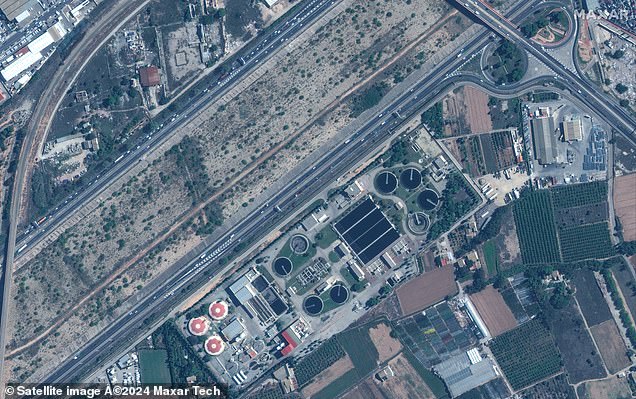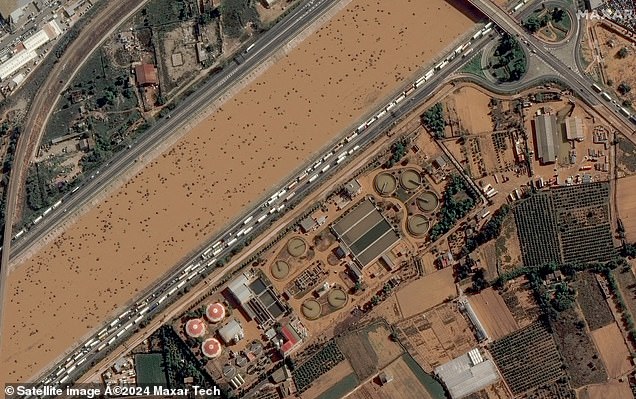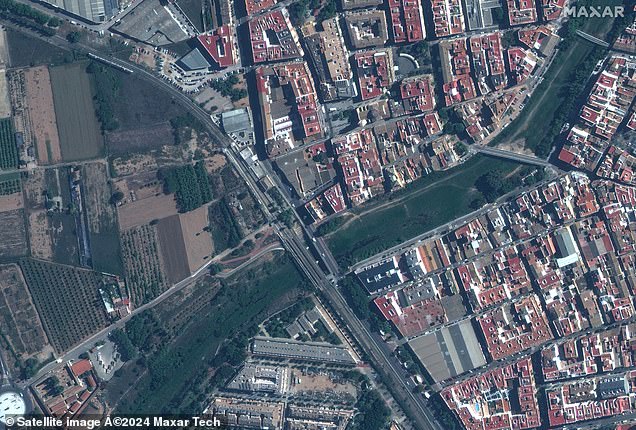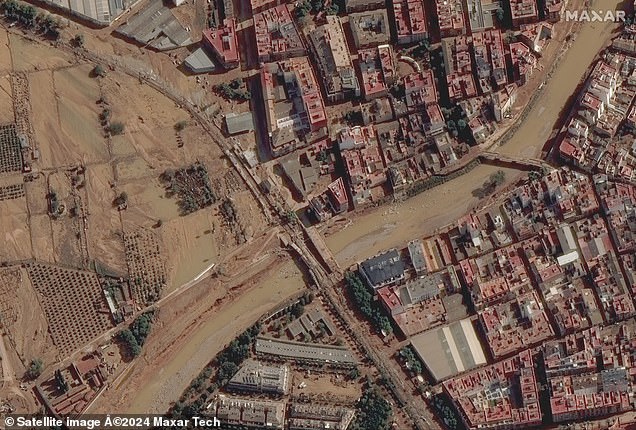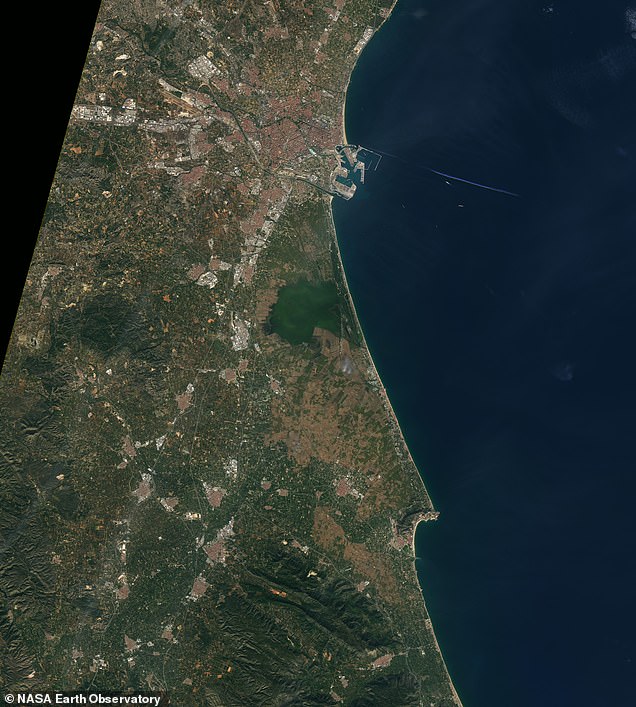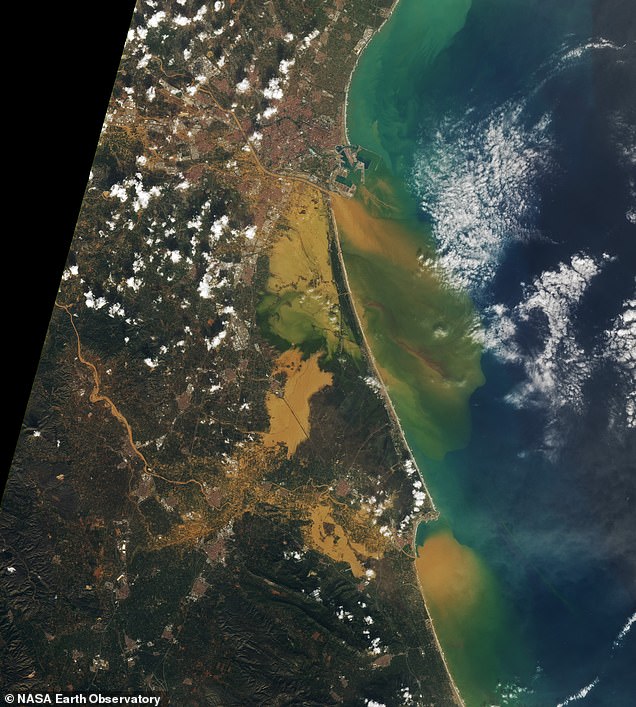Spain has been hit by its deadliest natural disaster in decades as devastating flash floods devastated the country’s eastern coast.
In Valencia, entire communities were submerged under water when the region received a year’s worth of rain in just eight hours.
Now, shocking satellite photographs reveal the true extent of the devastation.
The images, taken by the Copernicus Earth monitoring program, show areas where thousands of people have been trapped inside their homes.
In the south of Valencia, two days after the start of the floods, large areas of countryside were still submerged.
And near the coast, you can see the enormous column of mud carried into the ocean by the torrents.
Copernicus estimates that 11,000 people have been affected in the city of Algemesí alone, where more than 100 kilometers (60 miles) were flooded.
Across the region, 158 deaths have already been reported, and the number is expected to increase in the coming days.
These satellite images show the Valencia water treatment plant before (left) and after (right) the deadly flash flood that devastated
These photos show the Paiporta district of Valencia before (left) and after (right) the flood. You can see how the Paiporta bridge was destroyed by the furious waters
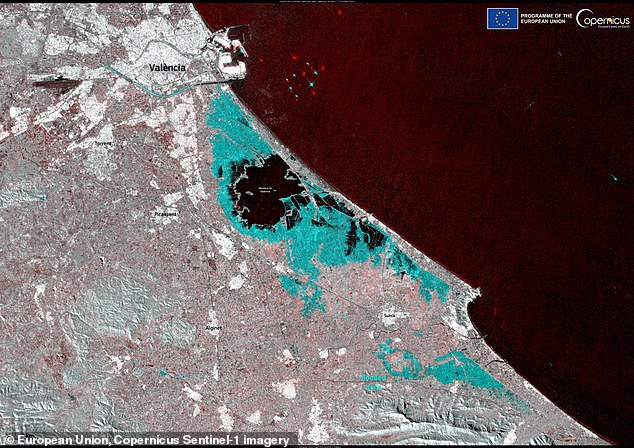
Satellite images taken by the EU’s Copernicus satellite program have revealed the true extent of the disastrous Valencia floods. In this image taken on October 31, the areas marked in blue were flooded.
The Valencia floods began on October 29 when the region was hit by an unprecedented storm.
The resulting flash flood spread across Valencia and its nearby towns, leaving hundreds of people trapped in their homes, with many even forced to climb trees, scale lamp posts and desperately run to the upper floors of buildings to escape.
It is the worst flood-related disaster in Spain since 1996, when 87 people died and 180 were injured in a flash flood near Biesca in the Pyrenees.
In an image taken by the Copernicus Sentinel-1 satellite, flood levels can be seen as they were on October 31.
The blue shaded areas represent areas that were still flooded at the time the satellite passed overhead.
As you can see, the area around the Albufera lake has been heavily flooded, with the waters extending as far south as the town of Sueca.
Within the city of Valencia itself, flooding has been more concentrated, largely affecting the area around the River Turia, which was diverted in the 1960s as a flood defense.
Closer inspection reveals a variety of smaller flood hotspots around the city, mainly along highways and large streets that allowed water to flow freely.
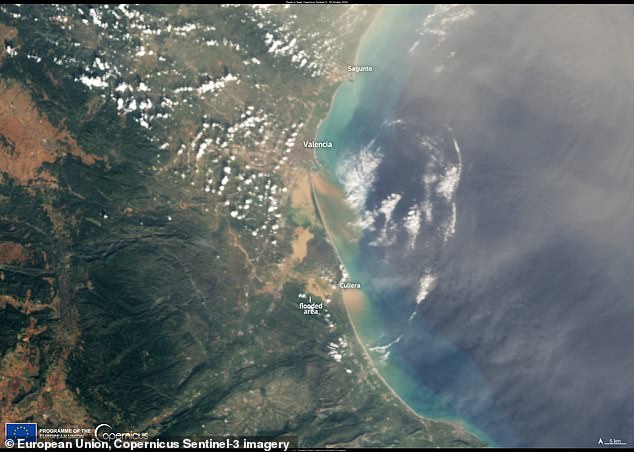
In this image taken by the Copernicus Sentinel-3 satellite, you can see the enormous column of brown mud swept out to sea by the force of the flood.
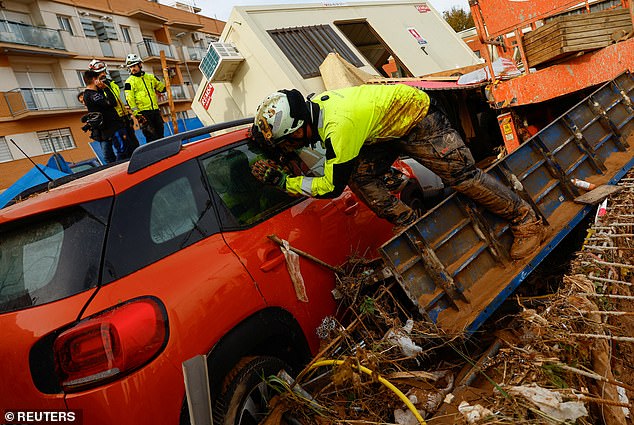
Search and rescue teams have begun searching for survivors (pictured), 155 people have already been confirmed dead
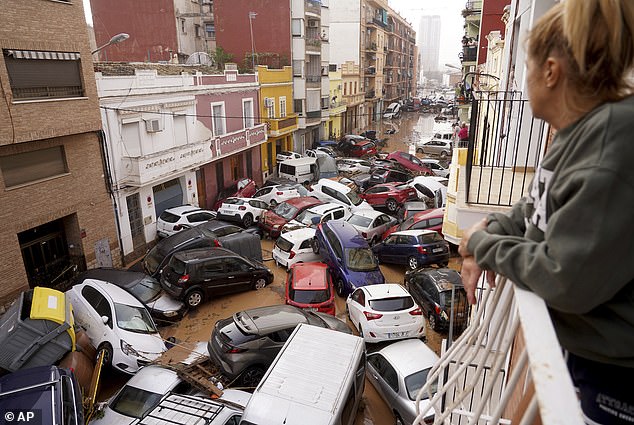
The city of Valencia (pictured) and its surrounding areas were hit by Spain’s deadliest natural disaster in decades when flash floods turned streets into rivers.
A second image, taken on October 30, shows the staggering extent of the flooding in its true colors.
In the satellite photograph you can see a wide area of brown water that extends south of Valencia towards the town of Cullera.
This enormous expanse of water is what was left when the rains hit the region.
Copernicus says: “The enormous amount of sediment dumped into the Mediterranean Sea by the rivers of the Valencian Community is clearly visible in this Copernicus Sentinel-3 image.”
In the sea near Valencia you can see the brown patch of mud that was thrown into the ocean.
Most of the sediment is being deposited near the mouth of the Turia, where the flood waters were most concentrated.
Another satellite photograph from NASA’s Earth Observatory shows that the worst of the devastation is concentrated south of the Turia.
In these areas, entire streets, neighborhoods and cities were covered by dark brown waters.
These satellite images taken by NASA’s Earth Observatory show the region before (left) and after (right) the flood submerged entire towns underwater.
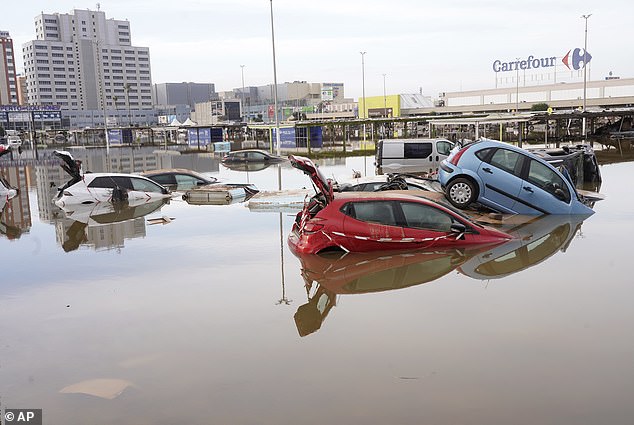
Valencia received a year’s worth of rain in just eight hours, which caused the water to rise several meters in some areas of the city.
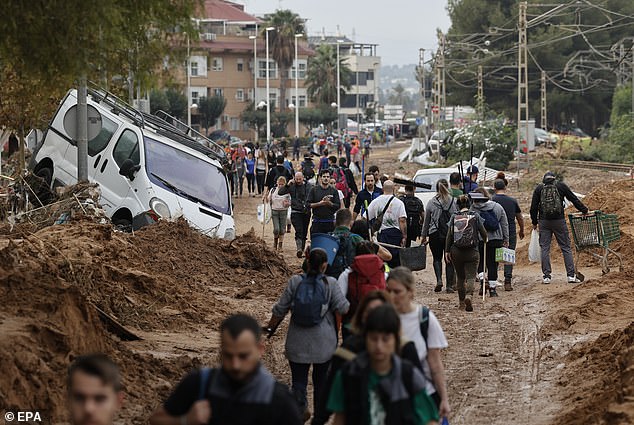
People walk through an affected area of Paiporta, Vallencia. The streets have been filled with sediment from floods and cars destroyed by the force of the water
These satellite observations also allow scientists to begin to understand the true scale of the devastation in the region.
Using satellite measurements, Copernicus estimates that 2.2 square miles (5.68 square kilometers) were submerged by water.
The flooding is believed to have directly affected the homes of 11,000 of the city’s 27,000 people, as well as covering 60 miles (100 kilometers) of roads and four miles (6.4 kilometers) of railways.
In the Valencia region, Copernicus estimates that more than 100,000 homes have been left without electricity.
As cleanup efforts continue, the exact levels of loss will become clearer, but it is already clear that these floods have been absolutely devastating.
In the town of Paiporta, shocking video showed a bridge collapsing under the weight of flood water.
Terrified onlookers screamed as the concrete pillars cracked and finally gave way and sank into the water, streetlights were seen flickering briefly before they were abruptly extinguished and lost beneath the raging floodwaters.
The first fatalities were confirmed by the Valencian political leader, Carlos Mazón, early on Wednesday with the news of “several fatalities” in the town of Letur.
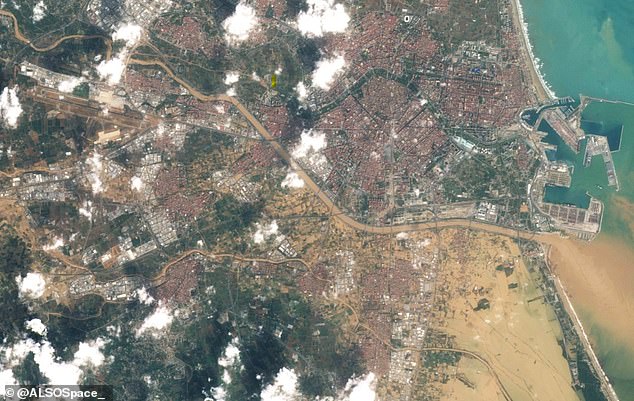
A satellite image of Valencia clearly shows where the worst affected areas of the city are, as brown floodwaters cover vast regions of land south of the city.
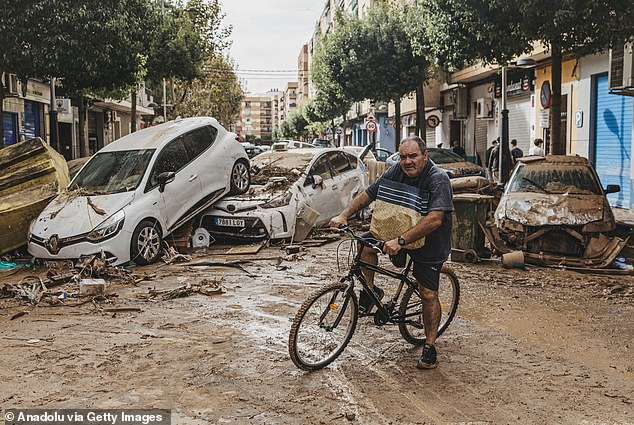
A man cycles past broken down cars in the Sedavi district of Valencia, it is estimated that more than 100,000 homes are currently without electricity in the region
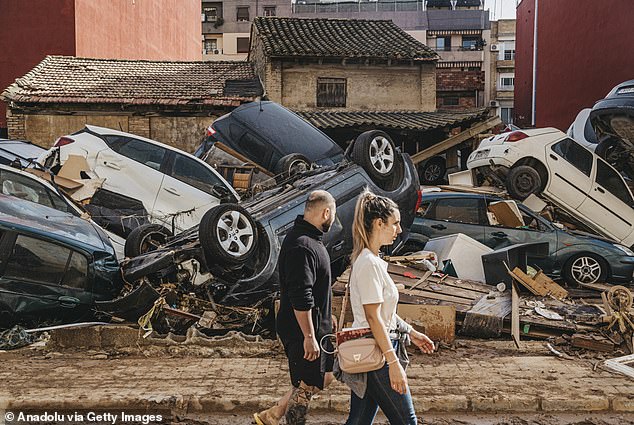
The Spanish government has convened a crisis committee and deployed 1,000 soldiers to the region. The true extent of the devastation will likely only become clear in the coming days. In the photo, the Valencian region of Sedavi.
At least 158 are now believed to have died in the Valencia region, but rescuers expect more bodies to be found as the water recedes.
This morning, the President of the Government, Pedro Sánchez, tried to reassure the victims by telling them that the Government “will not abandon them.”
‘All of Spain cries with all of you. Our absolute priority is to help them… We will not abandon them,” Sánchez said in a televised speech.
The Spanish government announced the creation of a crisis committee – the equivalent of Britain’s Cobra emergency response committee – as the magnitude of the disaster became clear.
Defense Minister Margarita Robles said this morning that more than 1,000 members of the UME Military Emergency Unit, a branch of the Spanish Armed Forces, had been mobilized to assist in rescue efforts in the province of Valencia.

